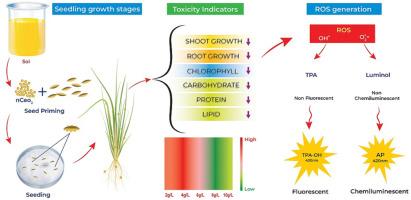揭示纳米二氧化铈对水稻的主要毒性指标及植物毒性机制
IF 8.1
2区 环境科学与生态学
Q1 ENVIRONMENTAL SCIENCES
引用次数: 0
摘要
二氧化铈纳米粒子(nCeO2)种类繁多,应用广泛,促进了其在生物系统中的不可控排放。因此,本研究以水稻(Oryza sativa)为模式植物,采用中性带电、粒径为12 nm的球形nCeO2 (0 g/L、2 g/L、4 g/L、6 g/L、8 g/L &;10 g / L)。并与散装氧化铈对应物进行了比较。本研究主要从关键毒性指标、纳米颗粒吸收和聚集机制等方面对nCeO2在水稻中的植物毒性进行系统评价。通过本研究,我们提出了一种新的非荧光/非化学发光分子检测活性氧(ROS)产生的方法,以研究植物毒性的机制。并详细阐述了ros诱导植物毒性的聚集机制。该研究表明,只有在较低浓度的nCeO2(≥4 g/L)暴露下,活性氧产生的增加才会导致水稻细胞进行性损伤。研究结果表明,nCeO2的主要毒性指标和实际的纳米颗粒吸收和聚集机制将决定nCeO2对水稻的植物毒性程度。本文章由计算机程序翻译,如有差异,请以英文原文为准。

Unveiling the key toxicity indicators and mechanisms on phytotoxicity of cerium dioxide nanoparticles in rice (Oryza sativa)
The splendid varieties of cerium dioxide nanoparticles (nCeO2) and their diverse applications stimulated their uncontrolled discharge in the biological system. So, in the present study, Oryza sativa was adopted as a model plant and its phytotoxic effects were studied with neutrally charged, >12 nm sized spherical nCeO2 (0 g/L, 2 g/L, 4 g/L, 6 g/L, 8 g/L & 10 g/L). The studies were also conducted with bulk ceria counterparts and compared. This work is focused on a systematic approach to evaluate the phytotoxicity of nCeO2 in Oryza sativa, in terms of key toxicity indicators, nanoparticle uptake, and aggregation mechanisms. With this study, we propose a new sensing approach with non-fluorescent/non-chemiluminescent molecules for the detection of the generation of reactive oxygen species (ROS) to study the mechanism of phytotoxicity. An aggregation mechanism was also detailed to explicate the ROS-induced phytotoxicity. The study demonstrates that an increase in the production of ROS causes progressive cellular damage in Oryza sativa only at lower exposure level concentrations of nCeO2 (≥4 g/L). Our findings revealed that the key toxicity indicators and the actual nanoparticle uptake and aggregation mechanisms will decide the extent of phytotoxicity of nCeO2 in Oryza sativa.
求助全文
通过发布文献求助,成功后即可免费获取论文全文。
去求助
来源期刊

Chemosphere
环境科学-环境科学
CiteScore
15.80
自引率
8.00%
发文量
4975
审稿时长
3.4 months
期刊介绍:
Chemosphere, being an international multidisciplinary journal, is dedicated to publishing original communications and review articles on chemicals in the environment. The scope covers a wide range of topics, including the identification, quantification, behavior, fate, toxicology, treatment, and remediation of chemicals in the bio-, hydro-, litho-, and atmosphere, ensuring the broad dissemination of research in this field.
 求助内容:
求助内容: 应助结果提醒方式:
应助结果提醒方式:


